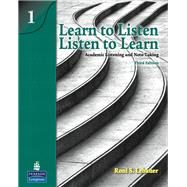
Note: Supplemental materials are not guaranteed with Rental or Used book purchases.
Purchase Benefits



What is included with this book?
Unit 1 STARTING OUT: PRE-COURSEWORK EVALUATION
A. Evaluating Listening Comprehension and Note-Taking Skills
LECTURE 1: Study Tips (Psychology)
B. Teacher’s Note-Taking Feedback Form
Unit 2 UNDERSTANDING LECTURE DESIGN
A. Comparing the Language of Lecturing to the Language of Writing 1
B. Recognizing Cues
C. Recognizing Paraphrase, Repetition, Exemplification, and Digression
D. Summarizing Key Differences between the Language of Lecturing and
the Language of Writing
E. Getting the Main Ideas Using Context and Prediction
F. Predicting Content and Lecture Direction
Unit 3 RECOGNIZING INTRO DUCT ONS, CO NCL USIONS, AND DIGRES SIONS
A. Using Introductions to Recognize Lecture Focus and Direction
B. Recognizing and Comprehending Conclusions
C. Recognizing Digressions
Unit 4 THE BASICS OF NOTE-TAKING
A. Noting Key Words
B. Using Abbreviations Thoughtfully
C. Using Note-Taking Symbols and Abbreviations
D. Visually Representing Relationships and the Relative Importance
of Information
LECTURE 2: "Nu Shu": Women’s Unique Language (Linguistics)
E. Eight DOs and DON’Ts for Improving Lecture Comprehension and
Note-Taking
Unit 5 NOTING NUMBERS AND STATISTICS
A. Differentiating between Numbers That Sound Similar
B. Noting Years
C. Noting Large Numbers in Isolation
D. Noting Fractions and Decimals
E. Noting Ratios
LECTURE 3: Exploring a Market: Attitudes towards pets (Business/Sociology)
LECTURE 4: Tobacco through the Millennia (Agriculture/History)
Unit 6 FOCUS ON LECTURE ORGANIZATION (PART 1)
A. Why Listen for Organization?
B. Organizational Plans within Lectures
C. Defining a Term
D. Listing Subtopics
E. Describing a Causal Relationship
LECTURE 5: How to Deal with Stress (Psychology)
LECTURE 6: Acid Rain (Ecology/Chemistry)
Unit 7 FOCUS ON LECTURE ORGANIZATION (PART 2)
A. Exemplifying a Topic
B. Describing a Process or Sequence of Events
C. Classifying Subtopics
LECTURE 7: Archaeological Dating Methods (Anthropology)
LECTURE 8: Pheromones (Biology)
Unit 8 FOCUS ON LECTURE ORGANIZATION (PART 3)
A. Describing Characteristics
B. Comparing and Contrasting
C. Making a Generalization and Providing Evidence
LECTURE 9: The Near Side of the Moon (Astronomy)
LECTURE 10: Drink Your Green Tea! (Food Science)
Unit 9 TYING IT TOGETHER: END-OF-COURSE EVALUATION
LECTURE 11: Voter Turnout in the United States (Political Science)
LECTURE 12: The Pyramids of Egypt: An Engineering Feat (Engineering/History)
Appendix A Academic Word List Vocabulary
Appendix B Lecture Index by Organizational Plan
Appendix C Lecture Index by Subject Matter
Appendix D Rewritten Notes for Lectures 5—10
The New copy of this book will include any supplemental materials advertised. Please check the title of the book to determine if it should include any access cards, study guides, lab manuals, CDs, etc.
The Used, Rental and eBook copies of this book are not guaranteed to include any supplemental materials. Typically, only the book itself is included. This is true even if the title states it includes any access cards, study guides, lab manuals, CDs, etc.